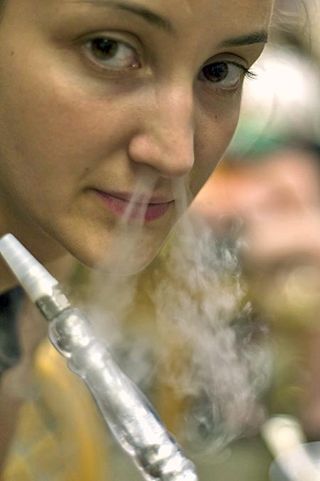Warning: Homegrown Tobacco Still Deadly

Across the backyards and victory gardens of America this fall, many weekend gardeners for the first time are harvesting a touch of poison amongst the squash and potatoes.
The poison, albeit all-natural and organic, is tobacco, an otherwise lovely plant with its elephantine green leaves and broad, five-petal flowers of yellow, pink or white.
Ever ingenious American smokers have turned to growing their own tobacco as the average price for smokes has climbed to over $6 a pack, a price hike largely the result of the $1.01-per-pack tax that went into effect on April 1, conveniently around planting season. Seed sales reportedly were through the roof this year.
Whether homegrown tobacco is cheaper is debatable. Growing tobacco is difficult for even the experienced gardener, and curing the leaves can be an art form.
But the parallel reasoning for growing your own — that homegrown tobacco is healthier by virtue of having none of the additives found in commercial cigarettes, as purported on various Internet sites — unfortunately is not true. The stuff will still kill you.
Not even marginally less harmful
Terms such as “healthier” or “safer” — as in the elusive safer cigarette that the tobacco industry is trying to create — should tell you who is shaping this argument. The proper term is “less harmful,” and even this is highly suspect. You’re still breathing in myriad cancer-causing agents; one or two fewer carcinogens, like one or two fewer bullets from a machine gun, doesn’t matter.
Sign up for the Live Science daily newsletter now
Get the world’s most fascinating discoveries delivered straight to your inbox.
Commercial tobacco does contain a lot of junk. The industry has hundreds of additives in its arsenal to make cigarette smoking a more pleasant and addictive experience. Some of these additives are carcinogenic. But good ol’ natural tobacco, particularly when burned, has upwards of 40 known or probable carcinogens that trump any harm done by additives.
Also, homegrown tobacco still has those same wonderful heart-stopping qualities causing higher blood pressure, higher cholesterol levels, and higher risk of artery clotting and stroke.
Part of the blame for the confusion goes to the anti-smoking movement. Its emphasis on tobacco additives has implied that natural tobacco is somehow healthier.
Maybe worse
While gardening is therapeutic, there’s irony in every puff of organic, homegrown tobacco, because the nicotine you’re absorbing is a deadly pesticide.
First, be careful handling fresh tobacco leaves. Touching wet leaves can cause green tobacco sickness, a type of nicotine poisoning. The sickness frequently affects tobacco harvesters, usually migrant workers lacking adequate protection.
Children exposed to high levels of nicotine from wet leaves often require hospitalization.
Next, should you succeed in growing your own, note that your exposure to the most deadly carcinogens — polycyclic aromatic hydrocarbons, such as benzene — might be greater than that from a regular cigarette, depending on the type of tobacco, the nature of the rolling, and the probable lack of filter. Thousands of chemicals are created by lighting tobacco, and the quantity of poisons varies based on airflow, temperature and other factors.
Of alchemy and cigarettes
Creating a less harmful cigarette is theoretically possible. One problem is that this type of product could be used as an alternative to tobacco cessation. Another problem is that it might encourage others to smoke more.
The tobacco industry understands this, for it has been fudging or hiding data for years. Low-tar and light cigarettes indeed encouraged smokers to switch to these so-called safer products, which offered not even a marginal health benefit.
Nevertheless, Philip Morris USA and other cigarette makers are investing millions in the creation of the safer cigarette. One advance is a curing process that reduces the presence of nitrosamine, one of the more potent tobacco carcinogens.
Most public health experts have zero trust in the tobacco industry. In 2001, the Institute of Medicine issued a report faintly welcoming the creation of a safer cigarette as a feasible component of a harm-reduction strategy. The National Cancer Institute, however, remains adamantly against this.
Given the tobacco industry’s history of duplicity, Alan Bluma of University of Alabama Center for the Study of Tobacco and Society might have summed it up the best in his 2008 review in the Lancet, stating, “The search for a safer cigarette is akin to alchemists seeking to turn lead into gold.”
You might want to leave more room for squash.
- 10 Easy Paths to Self Destruction
- Smoking’s Many Myths Examined
- Video – Addiction is in Your Genes
Christopher Wanjek is the author of the books “Bad Medicine” and “Food At Work.” His column, Bad Medicine, appears each Tuesday on LiveScience.

Christopher Wanjek is a Live Science contributor and a health and science writer. He is the author of three science books: Spacefarers (2020), Food at Work (2005) and Bad Medicine (2003). His "Food at Work" book and project, concerning workers' health, safety and productivity, was commissioned by the U.N.'s International Labor Organization. For Live Science, Christopher covers public health, nutrition and biology, and he has written extensively for The Washington Post and Sky & Telescope among others, as well as for the NASA Goddard Space Flight Center, where he was a senior writer. Christopher holds a Master of Health degree from Harvard School of Public Health and a degree in journalism from Temple University.
